|
“Watch the setting midwinter sun from ‘inside’ Maeshowe”
December 21, 2003, Maeshowe Webcam, Orkney Islands:
“Welcome to the Maeshowe Webcam Site
This Internet broadcast from Orkney’s 5,000 year-old Neolithic chambered cairn remains unique. There are three cameras sending images from Maeshowe.
The other partner and co-founder in this project is Victor Reijs, who has done much work on archaeoastronomy and whose visit to Orkney eight years ago was the inspiration for the project.
[Full Story]
“Eyes on the Solstice: Darkest day part of many cultures”
December 20, 2003, Billings Gazette, USA: “Humans are afraid of the dark. For millennia, diverse societies have found a way to honor the light.
From Neolithic farmers in Ireland to Pueblo peoples in the Southwest to Christians celebrating Advent to neopagans marking the annual descent of the sun in the Northern Hemisphere, all acknowledge winter solstice. Sunday marks the year’s longest night, shortest day.
Archaeologists reported the Goseck circle’s identity and age this past August. First spotted by airplane, the circle is 75 meters wide.
The ancients dreaded it for fear the sun was dying. That dread led to multitudinous rituals to welcome the halt of the sun’s decline and the lengthening of the days. Winter is rich in the traditions of mythology: of life, death and rebirth. A tradition that dates back at least 5,000 years.
A large passage grave tomb exists at a Neolithic site dating from 3200 B.C., at Newgrange, Ireland. It is about 40 feet high and nearly 300 feet across. It dominates the landscape overlooking the Boyne River Valley northwest of Dublin.
The tomb, built over several generations, is aligned so the sun’s rays passing through the roof box above the entrance illuminate the central chamber on the morning of Dec. 21, the winter solstice.
The passage of the tomb is about 60 feet. The interior chamber has three recesses, each with stone basins in which cremated human remains were placed.
Some archeologists believe that the remains of members of the Newgrange settlement who had died in the previous year were placed in the basins during the winter solstice ceremony as it marked the beginning of the new year.
[Full Story]
“Circles for Space: German ‘Stonehenge’ marks
oldest observatory”
December 08, 2003, Scientific American, USA: “A vast, shadowy circle sits in a flat wheat field near Goseck, Germany. No, it is not a pattern made by tipsy graduate students. The circle represents the remains of the world’s oldest observatory, dating back 7,000 years.
Coupled with an etched disk recovered last year, the observatory suggests that Neolithic and Bronze Age people measured the heavens far earlier and more accurately than scientists had imagined.
Archaeologists reported the Goseck circle’s identity and age this past August. First spotted by airplane, the circle is 75 meters wide.
Originally, it consisted of four concentric circles – a mound, a ditch and two wooden palisades about the height of a person – in which stood three sets of gates facing southeast, southwest and north, respectively. On the winter solstice, someone at the center of the circles would see the sun rise and set through the southern gates.
Although aerial surveys have demarcated 200-odd similar circles scattered across Europe, the Goseck structure is the oldest and best preserved of the 20 excavated thus far, and it is the first circle whose function is evident.
Though called the German Stonehenge, it precedes Stonehenge by at least two millennia. The linear designs on pottery shards found within the compound suggest that the observatory was built in 4900 B.C..
Perhaps the observatory’s most curious aspect is that the roughly 100-degree span between the solstice gates corresponds with an angle on a bronze disk unearthed on a hilltop 25 kilometers away, near the town of Nebra.
The Nebra disk, measuring 32 centimeters in diameter, dates from 1600 B.C. and is the oldest realistic representation of the cosmos yet found. It depicts a crescent moon, a circle that was probably the full moon, a cluster of seven stars interpreted to represent the Pleiades, scattered other stars and three arcs, all picked out in gold leaf from a background rendered violet-blue – apparently by applying rotten eggs.
[Full Story]
“Dig unearths Bronze Age sun disc”
November 25, 2003, BBC Science News, UK: “An ancient gold disc which was used as an item of adornment at a burial 4,000 years ago has been discovered in Ceredigion.
Experts say the priceless sun disc is the first one of its kind to be found in Wales and only the third known piece of gold from the Bronze Age uncovered here.
|
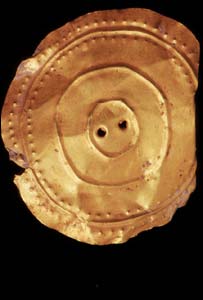
Copyright © 2003 BBC Science News
|
|
The disc found by chance by an archaeologist digging at Copa Hill at the Cwmystwyth Mines – 10 miles outside Aberystwyth – was the subject of a treasure trove inquest heard by Ceredigion coroner on Tuesday.
The find – roughly the size of a milk bottle top – is said to be as significant as the famous Mold cape – thought to have been worn as a garment for religious ceremonies by a great authority – the Bronze Age disc now housed at the British Museum.
Similar items have been found in Ireland and Europe, but never before in Wales.
|
If it is declared treasure trove, the National Museum of Wales will try to buy the sun disc for its collection, once its true value has been independently assessed.
Adam Gwilt, the museum’s curator, said: ‘Gold sun-discs are one of the very earliest kinds of metal objects ever to have been made and used in Britain and Ireland.’”
[Full Story]
“Ancient sun-disc declared treasure”
November 25, 2003, icWales/PA, Cymru: “A priceless gold sun-disc, dating back to an age when Stonehenge was still in its infancy, was declared to be treasure by a coroner today.
Experts say the Copper Age or early Bronze Age decorative artefact, no bigger than a milk bottle top, is one of the most exciting finds in years.
Freelance archaeologist Simon Timberlake unearthed the 4,000-year-old sun-disc during a routine search of a site in West Wales in October 2002.
The unexpected find later proved to be an example of one of the earliest kinds of metal object ever created in Britain and Ireland.
[Full Story]
“Archeologists discover Stonehenge in Macedonia”
November 14, 2003, XinhauNet, China: “An archeological team claimed that the megalithic archeological site of Tatikev Kamen in north Macedonia actually was a 4,000-years-old observatory, which indicated that there was a Stone henge in Macedonia, MIA news agency reported Thursday.
According to the team, the site discovered a year ago by archeologist Jovica Stankovski had served both as a ceremonial place and as an observatory.
The research carried out this year showed that the observatory had a specific place for monitoring the stars and the sun, as well as specific holes through which the movement of the sun and the moon could be recorded.
[Full Story]
“Moon mysteries of island stones”
November 05, 2003, The Scotsman, Scotland: “For 6,000 years the eerie standing stones at Callanish on Lewis have intrigued archaeologists and historians. The monuments, which were erected by Neolithic farming people, are believed to have a special association with the cycle of the moon.
A television programme, to be shown this weekend to coincide with a full moon and also a total eclipse of the moon, will explore the stones’ lunar importance.
The lunar association with Callanish will be examined in Moon Power, a BBC Natural World programme. The site includes a central circle with four limbs running out in line with the points of the compass.
Some of the stones are said to be aligned with the sun and moon at various times of the year and could have been used to predict eclipses and the coming of the seasons.
The programme will feature a simulation of a moonlit event which happens every 18 and a half years at Callanish and which culminates in the appearance of the ‘Earth Mother’, a figure seemingly outlined in the shape of the hills to the south of Callanish. The next event is not due to happen until 2006.
Local people call the image ‘Sleeping Beauty’ in English or ‘Cailleach na Mointeach’ in Gaelic – which translates as ‘The Old Woman of the Moors’.
After rising over the Earth Mother, the moon passes through the Callanish stones two to five hours later. As this happens, if a person stands on the hillock at the higher south end of the site, the moon is ‘reborn’ with a person silhouetted within it.
[Full Story]
“Lasers reveal invisible Stonehenge carvings”
October 17, 2003, New Scientist, UK: “Laser scanning has revealed ancient carvings on the pillars of Stonehenge that are invisible to the naked eye.
The experiment scanned just part of three of the 83 stones that make up the famous prehistoric monument in Wiltshire, UK.
|
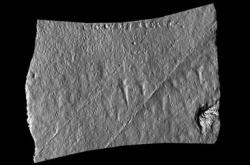
Copyright © 2003 New Scientist, UK
|
|
The archaeologists, from the Wessex Archaeology and Archaeoptics companies, hope a full survey could provide compelling evidence that Stonehenge was a memorial for the dead, at least at the time the carvings were made.
|
Carving of axe heads, as well as daggers and cups, have been found at burial sites all over the UK, Trueman told New Scientist: ‘They seem in some sense to be commemorating the dead.’
He thinks the same could be true at Stonehenge, especially as there are hundreds of burial sites in the area around the monument.
Other theories of Stonehenge’s purpose have centred on the fact that it was designed to line up with the sunrise on the morning of the summer solstice, and served as a calendar.
But the theories may not be mutually exclusive. The Sun could have had a symbolic value and been part of the memorial, suggests Trueman, or Stonehenge’s use could have changed over time.”
[Full Story]
“The megalithic yard”
August 21, 2003, The Guardian, UK: “In the mid 17th century the architect Inigo Jones was instructed to survey Stonehenge. He declared the ruins too sophisticated to have been built by the barbaric Druids and proposed a Roman origin.
Almost a century later, the antiquarian William Stukeley overturned Jones’ theory, noting the site’s ancient age and astronomical alignments. Stukeley also suggested the ruins shared a uniform system of measurement. Whoever they were, our ancient monument builders were no barbarians.
Two hundred years later, such notions were largely forgotten, the stones a quaint picnic spot still untouched by hippy hands. All that was about to change.
In 1967 came the publication of Megalithic Sites in Britain by Alexander Thom, a retired Oxford engineering professor who had spent more than a decade surveying megaliths throughout the land. Thom concluded that the builders used a standard unit of measurement, which he called the megalithic yard. This measured 2.72ft (40 megalithic inches, half a megalithic fathom), a number reached through statistical analysis of 145 stone circles.
To Thom, the design, placing and likely function of the stone circles showed the builders had a profound understanding of topography, astronomy and the measurement of time. They demonstrated a knowledge that would be lost for thousands of years.
[Full Story]
“Archaeologists Unearth German Stonehenge”
August 08, 2003, Deutsche Welle, Germany: “German experts on Thursday hailed Europe’s oldest astronomical observatory, discovered in Saxony-Anhalt last year, a ‘milestone in archaeological research’ after the details of the sensational find were made public.
|
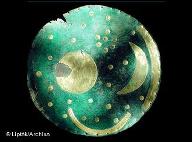
Copyright © 2003 Deutsche Welle, Germany
|
|
The sleepy town of Goseck, nestled in the district of Weissenfels in the eastern German state of Saxony-Anhalt shimmers under the brutal summer heat, as residents seek respite in the shade. Nothing in this slumbering locale indicates that one of the most significant archaeological discoveries of all times was made here.
|
But this is indeed exactly where archaeologists digging in the region last September stumbled upon what they believe is Europe’s oldest astronomical observatory ever unearthed.
Wolfhard Schlosser of the Ruhr University Bochum believes the site’s unique construction indicates that it is indeed one of the earliest examples of an astrological observatory.
Schlosser, a specialist in astro-archeology, says the southern gates marked the sunrise and sunset of the winter and summer solstice and enabled the early Europeans to determine with accuracy the course of the sun as it moved across the heavens. Schlosser is convinced the site was constructed for the observation of astronomical phenomena such as the movements of the sun, moon and stars, and for keeping track of time.
[Full Story]
“Archaeoastronomy Links Stone-Age Tomb Builders With Sun”
April 22, 2003, SpaceDaily, USA: “Scientific research at the prehistoric Passage Tomb Cemetery at Loughcrew, one of Ireland’s premier archaeological sites, is revealing new data on the astronomical orientations of the passage tombs and relationships in the way they are laid out.
|
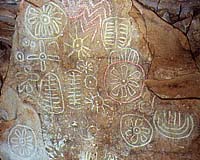
Copyright © 2003 SpaceDaily, USA
|
|
Using techniques from the science of archaeoastronomy, this research has already identified significant astronomical orientations in the larger focal tombs and significant patterns in the relative orientations of the monuments.
|
Frank Prendergast of the Dublin Institute of Technology presented the results of his research to date at the UK/Ireland National Astronomy Meeting in Dublin on Wednesday 9 April.
‘By examing the relationship between the landscape, the monuments and astronomy, we can complement existing archaeological knowledge and hopefully gain insight into how prehistoric communities might have perceived their place in the cosmos’, says Frank Prendergast.
Loughcrew is a nationally important archaeological landscape located 70 km north-west of Dublin in County Meath. It is the site of one of the four major passage tomb cemeteries in Ireland and dates from the Middle Neolithic (3600-3100 BC) and later.
Frank Prendergast’s investigations show that two of the largest focal tombs are oriented towards the rising Sun at the equinoxes. On these days, at dawn and for a period of some 20 minutes afterwards, the interior of the tombs are spectacularly illuminated by a shaft of sunlight.”
[Full Story]
“Cosmic link to stone circles”
April 09, 2003, BBC Science News, UK: “Stone Age people in Ireland appear to have built tombs based on a detailed knowledge of how the Sun moves across the sky during the year.
|
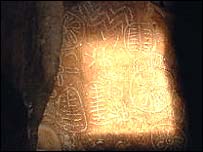
Copyright © 2003 BBC Science News
|
|
Tombs at the archaeological site of Loughcrew in County Meath align with the rising Sun at the spring and autumn equinoxes.
The inside of the chambers are spectacularly illuminated by a shaft of sunlight at dawn on these days, said Frank Prendergast of the Dublin Institute of Technology.
|
It suggests settlers in the area some 5 to 6,000 years ago knew the yearly cycle of the Sun and perhaps centred their lives around it.
Tombs found elsewhere in Ireland have been found to point towards the rising Sun at the summer and winter solstices.
At these times, the Sun reaches its most northerly and southerly points in the sky, which can be easily observed from any place on Earth.
Why tomb builders wished to do this remains a mystery but it suggests the Sun was at the heart of ritual and ceremonial practices of ancient people.”
[Full Story]
“Researchers use computers to turn Ohio’s ancient earthworks treasures into an interactive eye-opener”
March 20, 2003, Cincinnati Enquirer, USA: “People living in the Ohio River valley 2,000 years ago built earthworks as impressive as the pyramids of Egypt, experts say. And yet, today the earthen monuments are forgotten by many. It’s hard to appreciate what you cannot see.
Perhaps as many as 10,000 mounds and earthworks up to 15 feet high once existed in Ohio alone. They included sophisticated geometric shapes stretching thousands of feet.
Most have been destroyed in the past 200 years by agriculture, canal and road construction and other activities. Only a few, such as Fort Ancient in Warren County and Serpent Mound in Adams County, are visible today.
Three ancient cultures built earthworks in the Ohio River and Miami River valleys. The Adena (600 B.C.) constructed cones and rings. The Hopewell
(200 B.C. to 500 A.D.), built geometric enclosures and mounds.
The Fort Ancient people (700-1,200 A.D.) specialized in animal shapes. The earthworks were thought to be ceremonial centers tied to festivals and astronomical events.
[Full Story]
“Cursus: solving a 6,000-year-old puzzle”
March 2003 Edition, British Archaeology, UK: “Few monuments, from any period in history or prehistory, are as enigmatic as cursuses. These long – often ludicrously long – Neolithic enclosures have turned the concept of ‘mystery’ into an art form. Few have been properly excavated, and those that have, generally produced pitifully little by way of internal features, artefacts or dating evidence.
But despite this mystery, most archaeologists think they know a thing or two about these strange monuments. William Stukeley, the 18th century antiquary, famously thought the cursus at Stonehenge looked like a race-track – which is how cursuses got their name – and nowadays we all confidently scoff at that theory. Instead, we generally think of cursus monuments as ‘arenas for ritual processions’, referring to their invariably ‘massive scale’ and ‘permanence’ within the landscape.
But these fashionable theories don’t really add up either – at least, they cannot be generally applied. Some cursus sites are unlikely to have been used for processions. Some had rounded or squared off ends, others were open-ended. Some were very short-lived. Some were even fairly short. There are no rules.
Many cursuses were sited at transitional places, not only rivers but also at the crossover points of different types of geology. Confluences of two rivers seem to have been particularly favoured. It is notable that at Buscot, near Swindon in the Thames Valley, the relationship between the two cursus enclosures – in terms of relative size and orientation – mirrors that between the River Thames and the River Cole.
Overall, the varied settings and alignments of cursuses – linked to rivers, ridges, astronomical features, and the rest – seem to suggest a desire among Neolithic people to enmesh these monuments and the events taking place within them with prominent features of the natural world. Similar links are found in the settings of some long barrows and panels of rock art.
[Full Story]
“32,500-Year-Old Star Map Found”
February 01, 2003, Pravda, Russia: “This is probably the oldest constellation picture, whose age makes approximately 32,500 years. On a small piece of mammoth tusk, a human figure is pictured, with arms and legs situated in the same way as Oryon constellation.
The ivory tablet was found in 1979 in Asch Valley, in outskirts of the German city of Ulm. The dating of other things found along with the tablet allows to determine the age of the find as 32,500-38,000 years.
The tablet was left by a mysterious nation, Auriniaks. There is no information about them, expect but that they came to Europe from the East about 40,000 years ago and forced out native Netherlands population.
The tablet could have been, among other purposes, a pregnancy calendar. On its sides and on the back, there are 86 incisions which may have two meanings. On the one hand, this is the number of days which should be subtracted from full year to get the time of a human being gestation, and it is hardly a coincidence.
On the other hand, the most prominent pulsing star, making up the constellation, Betelgeise, could be seen for 86 days. For ancient people, this could mean a connection between gods in the sky and a human birth.
[Full Story]
“‘Oldest star chart’ found”
January 21, 2003, BBC Science News, UK: ” The oldest image of a star pattern, that of the famous constellation of Orion, has been recognised on an ivory tablet some 32,500 years old.
|
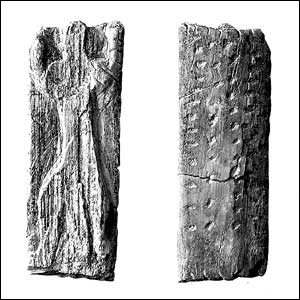
Copyright © 2003 BBC Science News
|
|
The tiny sliver of mammoth tusk contains a carving of a man-like figure with arms and legs outstretched in the same pose as the stars of Orion.
The claim is made by Dr Michael Rappenglueck, formerly of the University of Munich, who is already renowned for his pioneering work locating star charts painted on the walls of prehistoric caves.
The tablet also contains mysterious notches, carved on its sides and on its back.
|
These could be a primitive ‘pregnancy calendar’, designed to estimate when a pregnant woman will give birth.
It was found in 1979 in a cave in the Ach Valley in the Alb-Danube region of Germany. Carbon dating of bone ash deposits found next to the tablet suggest it is between 32,500 and 38,000 years old, making it one of the oldest representations of a man ever found.
The stars were in slightly different positions 32,000 years ago because they are moving across the sky at different speeds and in different directions, a phenomenon called ‘proper motion’.
Dr Rappenglueck allowed for this effect by using a computer program to wind back the sky and found evidence for a particular star in Orion that was in a different place all those years ago.
[Full Story]
|
|
useful books from our
Astro-Archaeology
Bookshoppe
“A Little History of
Astro-Archaeology”
John F. Michell

EU English Edition
“Stonehenge today is a battlefield, not only for police and festivalgoers at midsummer but also for rival camps of archaeologists, astronomers, and other researchers into the mysteries of prehistoric religion and science. Controversy flared up in 1963, when Gerald Hawkins made early use of the computer to identify Stonehenge as an observatory for the sun and moon and an instrument for predicting eclipses. Further studies of megalithic sites by Alexander Thom proved that many of them were also related to the seasonal positions of the heavenly bodies.
The study of astro-archaeology has now expanded worldwide, bringing new revelations about the mystical sciences of antiquity. This “little history” summarizes the issues involved in astro-archaeology, and illustrates its principal sites and personalities. Included are recent findings of British scientists, whose records of anomalous levels of natural energies at stone circles are in accordance with the magical reputations of such places in local folklore.”
“Megaliths, Myths and Men:
An Introduction to
Astro-Archaeology”
Peter Lancaster Brown

EU English Edition
“Noted British astronomer’s fascinating study of early astronomical knowledge through the interpretation of Stonehenge, Carnac, other megalithic sites. Stone Age sculpture, astronomical computations, radiocarbon dating, many other topics. Over 140 maps, photos, illustrations. The author has very comprehensively analysed several sites and shown how they can be used as astronomical machines.
He discusses the different interpretations of the sites and includes many diagrams of sites including the important astronomical alignments. Very enjoyable overview of archaeo-astronomy. Brown neatly debunks the lunatic fringe, reveals some of the unsung heroes of the field, and provides a clear summary of current ideas for the lay person.”
“Stonehenge: A New Interpretation of Prehistoric Man and the Cosmos”
John David North

EU English Edition
“Argues that Stonehenge’s scientific purpose was to observe the setting midwinter sun, and that astronomical observations made by the ancient Britons were as rational and methodical as they are today. North brings his distinguished background in astronomy to this study of Neolithic monuments. His aim is ‘to discover certain patterns of intellectual and religious behavior through a study of archaeological remains that seem to have been deliberately directed in some way towards phenomena in the heavens.’
Most of this book is a painstakingly detailed on-site investigation. Judging from the scale of Stonehenge and other monuments that incorporated astronomical alignments, North argues that the heavens played a central place in Neolithic and Bronze Age religion.”
“Astronomy in Prehistoric
Britain and Ireland”
Clive Ruggles
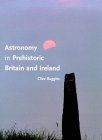
EU English Edition
“Do prehistoric stone monuments in Britain and Ireland incorporate deliberate astronomical alignments, and if so, what is their purpose and meaning? This work provides an account of megalithic astronomy debates and examines prehistoric man’s concern with celestial bodies and events. For decades debates have boiled among archaeologists and astronomers over the idea that prehistoric stone monuments in Britain deliberately incorporate astronomical alignments.
In this book Clive Ruggles is the first to approach the subject from the perspectives of both disciplines. He analyzes the history and lessons of previous debates, the most current research, and new agendas for future research.”
“Ancient Astronomers
(Exploring the Ancient World)”
Anthony F. Aveni
&
Jeremy A. Sabloff
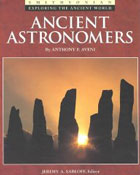
EU English Edition
“Anthony Aveni is well known in scholastic circles for his many excellent and ground-breaking publications in the field of archaeoastronomy. This particular volume is geared toward interested laymen and uninitiated scholars who are not yet well grounded in the history of astronomy or ideas of cosmology from an anthropological perspective. The book is graced with numerous and apt illustrations, while the text reads easily with Aveni’s smooth and informative style.
Chapters were clearly organized thoughtfully, as information builds upon previous explanations and new concepts or ideas are charted out for the neophytes as needed. “Ancient Astronomy” provides an ideal introduction to archaeoastronomy, ethnoastronomy, and cosmology for students in anthropology and the history of astronomy.”
“Prehistoric Astronomy
in the Southwest”
J. McKim Malville
&
Claudia Putnam
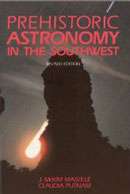
EU English Edition
“Archaeoastronomy is a discipline pioneered at Stonehenge and other megalithic sites in Britain and France. Many sites in the southwestern United States have yielded evidence of the prehistoric Anasazi’s intense interest in astronomy, similar to that of the megalithic cultures of Europe. The authors describe the astronomical alignments at the well-known sites of Chaco Canyon and Hovenweep and present new evidence, based on recent field work of alignments at Yellow Jacket, Chimney Rock, and Mesa Verde.
Drawing on the archaeological evidence, ethnographical parallels with historic pueblo peoples, and mythology from other cultures around the world, the authors present theories about the meaning and function of the mysterious stone alignments and architectural orientations of the prehistoric Southwest.”
“Stairways to the Stars: Skywatching in Three Great Ancient Cultures”
Anthony F. Aveni
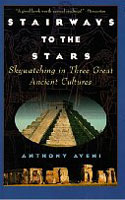
EU English Edition
“What is the meaning of Stonehenge? Why was the elaborate Incan city of Cuzco built? What is the significance of the Great Pyramid at the ancient Mayan city of Chichén Itz´? These ancient structures have spellbound natives and tourists alike. This mysterious architecture points to a centuries-old search for celestial order. Anthony Aveni, a professor of astronomy and anthropology, takes us on a stimulating virtual tour of these legendary constructions.
He describes how they were built and straightforwardly and often humorously critiques diverse theories attempting to explain their origin and function. For example, Aveni breathes life into the mysteries of the Great Pyramid and its use as a sacred temple, sacrificial altar, and celestial calendar.”
“Songs from the Sky: Indigenous Astronomical and Cosmological Traditions of the World”
V.D. Chamberlain (Editor)
J.B. Carlson (Editor)
M.J. Young (Editor)
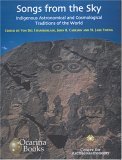
EU English Edition
“This substantial collection of papers on indigenous astronomical knowledge is quite unequalled in its scope and extent. The authors are drawn from a variety of academic disciplines, including anthropology, archaeology, astronomy, engineering, art history, history of science, history of religion, folklore, and mythology, and bring a variety of academic perspectives to bear upon aspects of celestial knowledge and perception in diverse social contexts from many different parts of the globe.
The Americas provide the main geographical focus, with twenty of the 32 papers concerning indigenous north American groups such as the Navajo, Lakota, Zuni and Blackfoot, the Mixe and Tzotzil Maya of southern Mexico, the Andean highlands and the Amazonian region of Peru, and southern coastal Brazil. The remaining twelve articles extend to the Arab world, sub-Saharan Africa, southern India, Java, Melanesia, Australia and Polynesia, with a few addressing broader synthetic themes. For a number of the culture areas dealt with in some detail here, other published information about sky knowledge is extremely scant.”
“Skywatchers, Shamans & Kings : Astronomy and the
Archaeology of Power”
E.C. Krupp
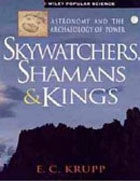
EU English Edition
“Prehistoric Astronomy
in the Southwest”
J. McKim Malville
&
Claudia Putnam

EU English Edition
“Ancient Astronomers
(Exploring the Ancient World)”
Anthony F. Aveni
&
Jeremy A. Sabloff

EU English Edition
“Records in Stone:
Papers in Memory of
Alexander Thom”
Clive Ruggles
(Editor)
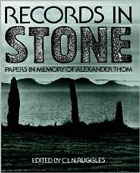
EU English Edition
“Stonehenge: The Secret of
the Solstice”
Terence Meaden
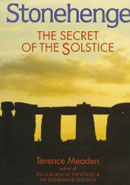
EU English Edition
“Early Man and the Cosmos”
Evan Hadingham

EU English Edition
“East Asian Archaeoastronomy: Astronomical Observations of
China, Japan and Korea”
Zhenoao Xu, Yaotiao Jiang
& David W. Pankenier

EU English Edition
“Under Ancient Skies:
Ancient Astronomy and
Terrestrial Catastrophism”
Paul Dunbavin
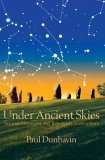
EU English Edition Only
but avialable
worldwide
|